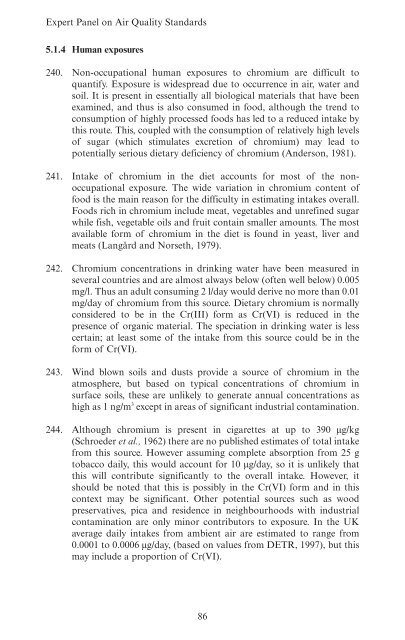Guidelines for Metals and Metalloids in Ambient ... - ARCHIVE: Defra
Guidelines for Metals and Metalloids in Ambient ... - ARCHIVE: Defra
Guidelines for Metals and Metalloids in Ambient ... - ARCHIVE: Defra
You also want an ePaper? Increase the reach of your titles
YUMPU automatically turns print PDFs into web optimized ePapers that Google loves.
Expert Panel on Air Quality St<strong>and</strong>ards<br />
5.1.4 Human exposures<br />
240. Non-occupational human exposures to chromium are difficult to<br />
quantify. Exposure is widespread due to occurrence <strong>in</strong> air, water <strong>and</strong><br />
soil. It is present <strong>in</strong> essentially all biological materials that have been<br />
exam<strong>in</strong>ed, <strong>and</strong> thus is also consumed <strong>in</strong> food, although the trend to<br />
consumption of highly processed foods has led to a reduced <strong>in</strong>take by<br />
this route. This, coupled with the consumption of relatively high levels<br />
of sugar (which stimulates excretion of chromium) may lead to<br />
potentially serious dietary deficiency of chromium (Anderson, 1981).<br />
241. Intake of chromium <strong>in</strong> the diet accounts <strong>for</strong> most of the nonoccupational<br />
exposure. The wide variation <strong>in</strong> chromium content of<br />
food is the ma<strong>in</strong> reason <strong>for</strong> the difficulty <strong>in</strong> estimat<strong>in</strong>g <strong>in</strong>takes overall.<br />
Foods rich <strong>in</strong> chromium <strong>in</strong>clude meat, vegetables <strong>and</strong> unref<strong>in</strong>ed sugar<br />
while fish, vegetable oils <strong>and</strong> fruit conta<strong>in</strong> smaller amounts. The most<br />
available <strong>for</strong>m of chromium <strong>in</strong> the diet is found <strong>in</strong> yeast, liver <strong>and</strong><br />
meats (Langård <strong>and</strong> Norseth, 1979).<br />
242. Chromium concentrations <strong>in</strong> dr<strong>in</strong>k<strong>in</strong>g water have been measured <strong>in</strong><br />
several countries <strong>and</strong> are almost always below (often well below) 0.005<br />
mg/l. Thus an adult consum<strong>in</strong>g 2 l/day would derive no more than 0.01<br />
mg/day of chromium from this source. Dietary chromium is normally<br />
considered to be <strong>in</strong> the Cr(III) <strong>for</strong>m as Cr(VI) is reduced <strong>in</strong> the<br />
presence of organic material. The speciation <strong>in</strong> dr<strong>in</strong>k<strong>in</strong>g water is less<br />
certa<strong>in</strong>; at least some of the <strong>in</strong>take from this source could be <strong>in</strong> the<br />
<strong>for</strong>m of Cr(VI).<br />
243. W<strong>in</strong>d blown soils <strong>and</strong> dusts provide a source of chromium <strong>in</strong> the<br />
atmosphere, but based on typical concentrations of chromium <strong>in</strong><br />
surface soils, these are unlikely to generate annual concentrations as<br />
high as 1 ng/m 3 except <strong>in</strong> areas of significant <strong>in</strong>dustrial contam<strong>in</strong>ation.<br />
244. Although chromium is present <strong>in</strong> cigarettes at up to 390 µg/kg<br />
(Schroeder et al., 1962) there are no published estimates of total <strong>in</strong>take<br />
from this source. However assum<strong>in</strong>g complete absorption from 25 g<br />
tobacco daily, this would account <strong>for</strong> 10 µg/day, so it is unlikely that<br />
this will contribute significantly to the overall <strong>in</strong>take. However, it<br />
should be noted that this is possibly <strong>in</strong> the Cr(VI) <strong>for</strong>m <strong>and</strong> <strong>in</strong> this<br />
context may be significant. Other potential sources such as wood<br />
preservatives, pica <strong>and</strong> residence <strong>in</strong> neighbourhoods with <strong>in</strong>dustrial<br />
contam<strong>in</strong>ation are only m<strong>in</strong>or contributors to exposure. In the UK<br />
average daily <strong>in</strong>takes from ambient air are estimated to range from<br />
0.0001 to 0.0006 µg/day, (based on values from DETR, 1997), but this<br />
may <strong>in</strong>clude a proportion of Cr(VI).<br />
86
















